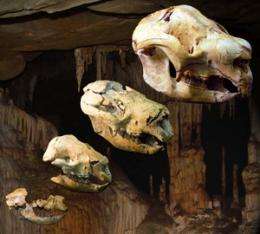Herds of large treetop marsupials

Sheep-sized ancient relatives of modern-day wombats lived in Australia’s treetops 15 million years ago, according to new research led by Dr Karen Black from the University of New South Wales.
The 70 kg marsupials – known as Nimbadons - were strikingly similar to koalas, says Dr Black, winner of the Australian Academy of Science’s 2012 Dorothy Hill Award for female researchers in the Earth sciences. Dr Black will discuss her preliminary findings as part of her presentation today at the Academy’s annual Science at the Shine Dome event.
“Nimbadon was a highly capable, habitual climber and its specialised anatomy suggests it may have adopted a trunk-hugging method of climbing similar to the living koala,” says Dr Black, whose collaborators are Dr Aaron Camens (Flinders University) and Professor Mike Archer and Associate Professor Sue Hand (both of UNSW).
The team’s research is still incomplete and has not yet been published, but Dr Black says it is already clear that Nimbadon's climbing ability would have allowed it to access multiple layers of the rainforest canopy.
“This ability would have reduced the competition it faced for food resources with other herbivores, such as kangaroos, and also to escape predators, such as marsupial lions.
“It may have also opportunistically fed on rainforest fruits and so played a role as a large seed disperser in Australia's ancient forests.”
The team’s research focuses on a 15-million-year old fossil cave at Riversleigh, in north-western Queensland. The cave is packed with even older animal bones and has revealed almost the entire life cycle of the Nimadon, from suckling young in the pouch still cutting their milk teeth to elderly adults.
“The Nimbadon fossil material is an incredibly rare and significant resource, not only because it is so exceptionally well-preserved, but because it represents individuals from a range of ages,” says Dr Black. “The Nimbadon material has allowed the first detailed study of skull development in a fossil marsupial as well as brain development and behaviour.”
Their study is also providing a time perspective on the nature and rate of environmental change affecting Australia's past ecosystems, which will help anticipate the impacts of future climate change on Australian biodiversity.
Provided by University of New South Wales




















